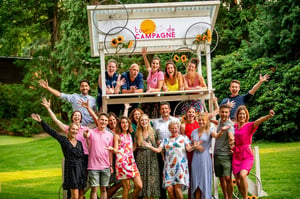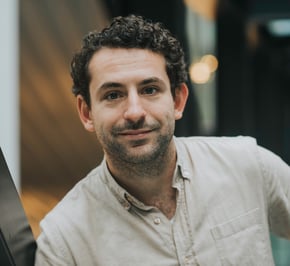Events are an essential part of the marketing and communication strategy of organisations. Yet, they are not always acknowledged as such, and proper objectives are missing too often. Sabine Dijkema, commercial director at D&B Eventmarketing, explains this in a joint interview with Rutger Bremer, founder of Momice. She also clarifies how the event agency profiles itself as a strategic director, and how Momice helps D&B Eventmarketing organise the communication of events.
Events reinforce the message like no other
Dijkema indicates she has been in love with her profession for more than a decade. Why? “Because I love to see what events can accomplish. They ensure a connection between the target audience and the organisation, or even bigger: society. That makes it all worthwhile. You cannot establish such a shared breathtaking moment with any other means of communication. The emotion and experience reinforce to the organisation’s message like no other. This is what makes events the most powerful way of communication that exists. I have therefore become a true event ambassador. I think event organisation is all about asking the following questions: What do you really want to accomplish with the attendees? How should they feel when they leave? What should one do, feel or think differently after an event?”
Impact through behavioural change
Rutger Bremer wonders what distinguishes D&B Eventmarketing from other parties. Dijkema: “We aim to create impact with each event. Whether it is about clients or employees: our goal is to ensure they feel, think or act differently after the event. That’s why it is so important to not see an event as a goal in itself, but as a means or driver to achieve something bigger. If you want to touch or inspire people, you should ask yourself: what message do you want to get across?”
Although D&B Eventmarketing and Momice talk about the same thing, Momice rather formulates event objectives in terms of behavioural change. Rutger: “Day-to-day issues are the biggest threat to behavioural change. If you go back to the office the day after an event to continue business as usual, the event had no effect. However, this is exactly what often happens. Many events lack proper objectives, as the results of a survey among 100 event indicate. It’s good to see D&B Eventmarketing turns the clients inside out. This is how your agency can really make a difference.”
Read more about objectives in this blog!
Events as a reflection of the organisation
Dijkema tries to focus on the ‘question behind the question’. “We claim to be able to use events as a strategic instrument to achieve objectives. It is based on marketing and communication and deserves attention on a strategic level.” According to Dijkema, events contribute to both internal goals, such as strengthening the culture, as external goals. “That is why it is important the event is aligned with positioning. For example, if you are a major polluter, don’t organise a sustainability. Events are part of marketing, and therefore deserve more marketing attention as well.”
Dijkema notices that many organisations feel urged to actively think about their culture and how they want to be seen. Dijkema: “Sometimes, an event is not the right channel. An employee party might not be the best idea if a reorganisation is in a financial crisis.” Bremer takes it a step further: “An event sometimes reflects the organisation: if something is internally wrong, an event will not get off the ground. On the other hand: if an organisation has their mission and culture all worked out, the objectives will quickly become clear as well. These two are interconnected.”
No connection, no strategy
Bremer confirms that the marketing and event departments are not always fond of each other. “Not to mention the connection between the board and event teams. Too often, an event team is only concerned with the execution.” Dijkema recognises this: “An event is often ordered top-down and sometimes we see that an inspired event manager not being heard by the board. That is a shame, since a healthy connection is critical for the overall event strategy.”
A Momice research shows that two out of three event professionals are working at an organisation where an overall event strategy does not exist. At the third edition of the Momice event series Connecting the Dots, Könemann & Dragt (Corporate event strategy) will explain the necessity of a solid overall strategy for events, and how to achieve it.
Event Director ensures involvement
D&B Eventmarketing works with so-called project teams, in which various departments get involved in the event. “Why wouldn’t you let finance, HR or Sales join brainstorm sessions about an event? They are the ambassadors of your event, leading to involvement, increased enthusiasm in the organisation and therefore the best input. This is way more efficient than communicating an event top-down.”
Dijkema advises organisations to ask the Sales department why clients come to an event. “Or ask the clients directly, so you could involve them in the creation of an event as well. This results in a concept that is relevant for every target audience. Don’t forget to report back what you did with their input, so they feel appreciated.”
Bremer states that D&B Eventmarketing’s approach sets a good example, that reminds him of the Event Blueprint. “It is a pity that not all organisations take a similar approach. Putting the client first is a good starting point, but it’s also worth it to investigate the needs of your target audience. We always do this when organising an event. Therefore, we always start our invitations with this question: ‘Do you want to learn X? Visit event Y!’ This indicates how you can help your invitee, because your target audience is clear.”
Learn how to use co-creation for events in this blog!
Digitalisation and sustainability
Dijkema is not surprised that not every organisation opts for co-creation yet. “After all, it does require a certain level of vulnerability. That can be scary for some organisations. However, it pays off. You will not stand out among the many event invitations if you’re not relevant for your network. I also think the communication after the event is important. Why wouldn’t you send the presentations as a podcast to those who didn’t or couldn’t attend? That’s is more substantive than a series of photos. This a way to digitalise the event organisation in the end.”
According to Dijkema, clients often overestimate the attendance rate of an event, which conflicts with sustainability goals. “The no-show will always result in food waste. Nowadays, this is a real no go. When thinking about sustainability, one should also translate that to the event organisation. Ask attendees if they are big eaters and whether they prefer meat or fish, for example. It’s admirable that the city of Amsterdam dares to take the lead in this issue by serving vegetarian food only. And why isn’t there a handy tool that enables carpooling for event visitors?”
Bremer: “For our last edition of Connecting the Dots, we came up with a no-show fee for invitees that did not show up at the event after all. Two trees will be planted for every 12,50 euros they donate. We don’t do this to punish the no-shows, but to compensate the CO2 emission and create awareness. A livestream could also be a solution. I think more events should offer this to their visitors - especially sustainability events.”
Momice supports D&B Eventmarketing's event communication
Dijkema: “The communication process is essential for events. An event is basically a form of live communication, and therefore inextricably linked to the communication department. An event can be a great start, central part or end of a campaign. Thanks to Momice, we can now communicate with our important relations in an easy and structured manner.”
D&B Eventmarketing considers Momice a handy solution and recommends it to her clients. “The best part is: you can, without being very tech savvy, adjust invitations and shape the standard format as desired. This results in good-looking mailings and makes it easier to plan the communication for your event. We chose Momice based on pricing, user-friendliness and quality. For me, the ability to see who is attending with one single click is of important added value. We also find checking visitors in by using the Momice Check-in app, without additional equipment, very convenient.”
Read more about the Momice Check-in app here!
Conclusion
Events can help you realise the organisation’s strategic objectives. However, it is not always easy to link those objectives to events or to determine the event objectives. Co-creation with colleagues, clients, prospects and suppliers can help you achieve this. When it comes to sustainability, there are still a lot of steps to take in digitalising events. Momice helps D&B Eventmarketing with the communication around events, resulting in well-managed invitations and registration.

